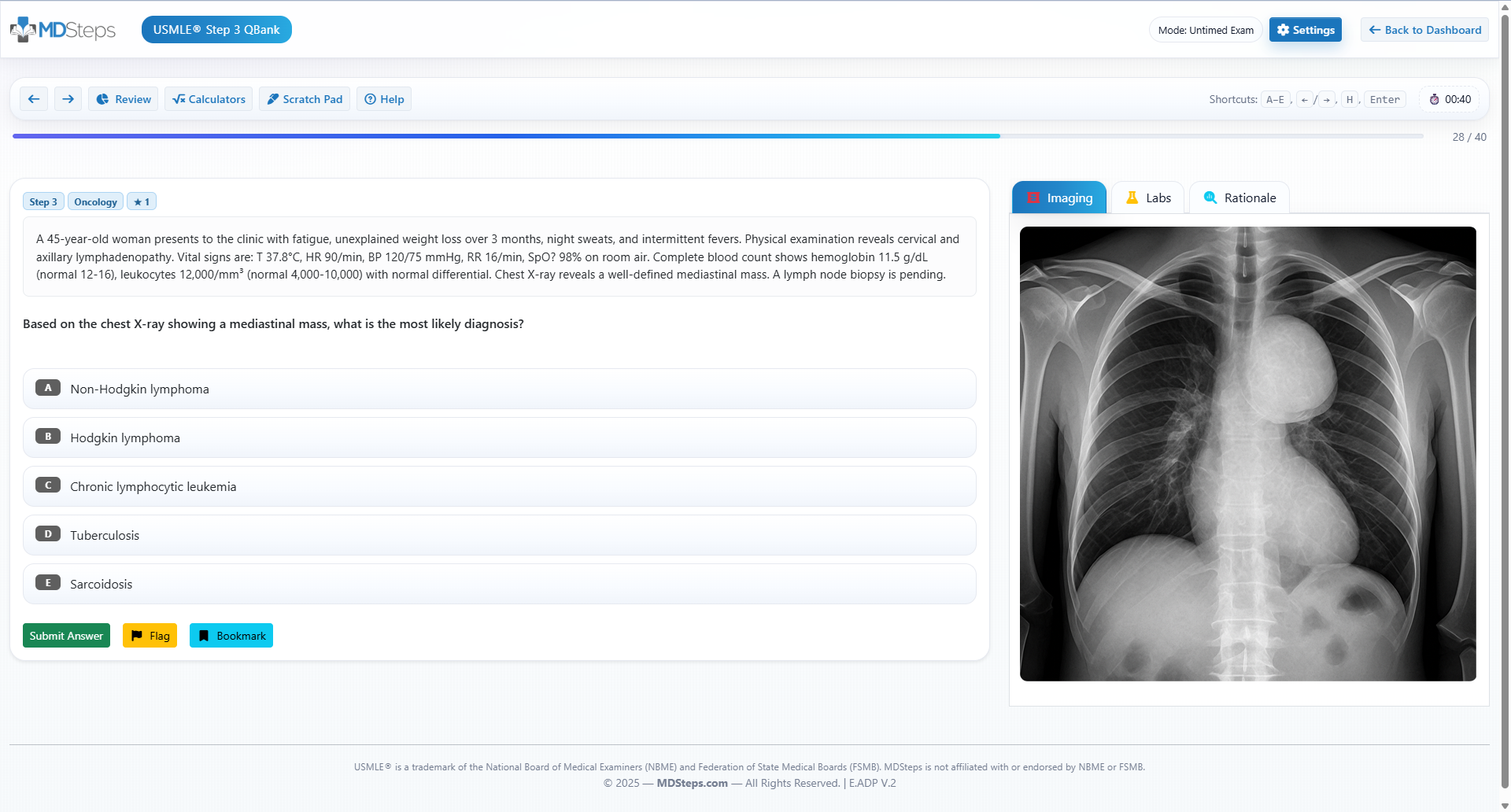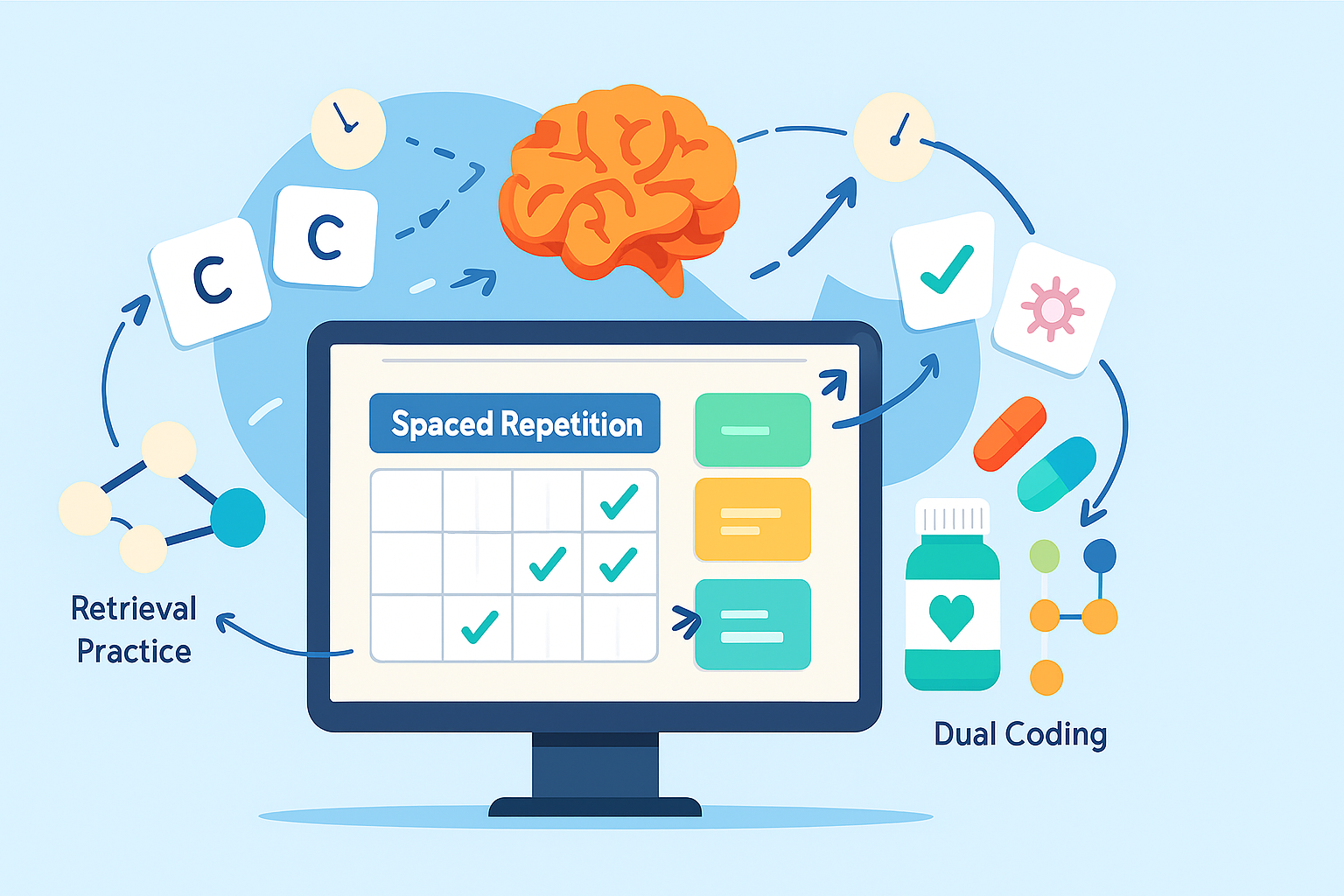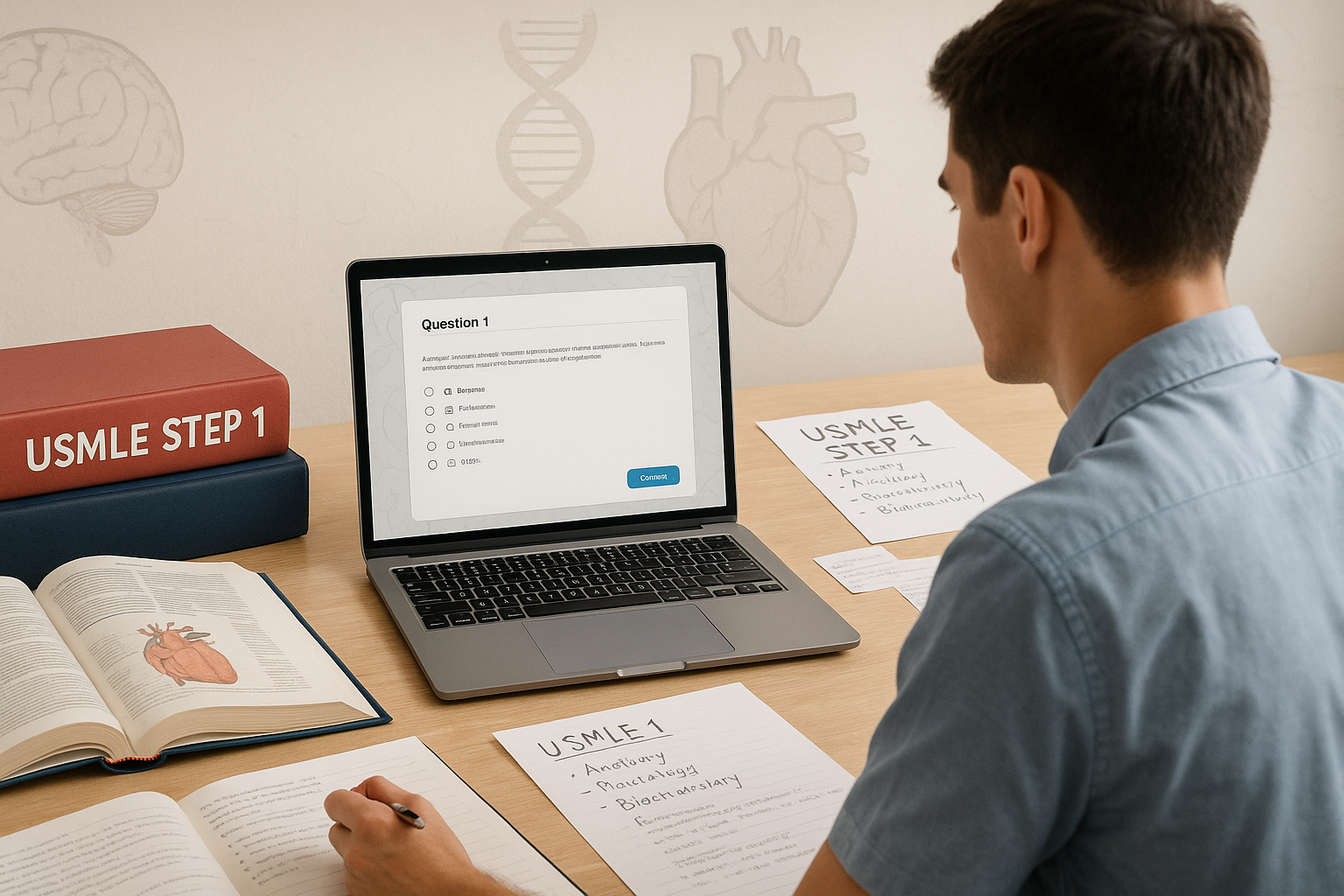Master your USMLE prep with MDSteps.
Practice exactly how you’ll be tested—adaptive QBank, live CCS, and clarity from your data.
- Adaptive QBank with rationales that teach
- 50+ CCS cases with live vitals & scoring
- Progress dashboard with readiness signals
Step 1’s pass/fail status shifted the target from raw score chasing to reliable competence: consistent recognition of high-yield patterns under time pressure. The most efficient way to build that competence remains test-enhanced learning, or retrieval practice: answering questions, getting immediate feedback, and then attempting again under varied conditions. This isn’t opinion—decades of work show that repeated testing produces more durable learning than rereading or passive study. In classic experiments, Roediger and Karpicke demonstrated that practice tests—not additional study—improve long-term retention; later reviews (e.g., Dunlosky et al.) confirm the large, generalizable benefits of retrieval, spacing, and interleaving for complex domains. For Step 1, the implication is clear: prioritize QBanks that (1) deliver authentic item formats and clinical vignettes, (2) offer high-signal explanations that teach mechanisms (not trivia), (3) support deliberate difficulty (paced blocks, mixed systems), and (4) provide analytics to expose blind spots. A good bank turns every miss into a calibrated next step; a great bank turns your pattern of misses into a personalized plan. When comparing options below, we evaluate the big four on item quality, explanation depth, interface fidelity to the exam, search/library integration, and feedback/analytics. We also indicate where even strong banks can waste time—for example, over-detailing rare pathways, under-specifying experimental vignettes, or surfacing too many same-stem repeats that inflate performance without improving transfer. We scored each QBank using a rubric aligned to Step 1 decision-making. The core pillars: Why this rubric? Because durable learning follows retrieval, spacing, and interleaving. Tools that force you to resurface concepts at rising difficulty—and to explain away distractors—yield better transfer to novel stems. Banks that bloat explanations or promote single-system drilling without mix-ups risk a false sense of mastery. Why it’s top-tier: UWorld’s Step 1 QBank delivers 3,600+ questions with exam-faithful vignettes, robust distractors, and thorough explanations that walk from mechanism to outcome. Interface fidelity (flagging, lab values, calculator) mirrors Prometric conditions, and custom blocks (mixed, by system, or random) let you stage difficulty progressively. For most examinees, UWorld remains the first (or second) pass backbone because it balances breadth with reasoning depth. Pitfalls: Density can work against you. Explanations are excellent but long; over-reading every sidebar turns sessions into reading comprehension rather than retrieval training. Also, difficulty distribution sometimes nudges toward multi-step puzzles that, while valuable, can bias you to over-invest in uncommon cross-links. Because UWorld is widely used, repeated exposure to popular stems via peers can create a familiarity halo that inflates perceived readiness without improving transfer. The fix is procedural: time most sessions (40 Q/60 min), cap review windows, and summarize misses in one mechanism sentence + one decision rule. Integrate scheduled mixed-set re-tests (every 48–72 hours) to leverage spacing rather than squeezing explanations for diminishing returns. Best use case: Primary pass (mixed blocks), then targeted second-pass of error tags before NBME practice. Pair with a shorter, adaptive bank to “tighten the loop” on your recurring error types. Why it’s top-tier: AMBOSS pairs a modern QBank with an integrated medical library; the “side-by-side” explanations and hover definitions keep you in flow when you need a quick refresher. AMBOSS advertises thousands of Step-style items and curates study plans (e.g., “30 Topics in 30 Days”) that can scaffold an IMG timeline or late start. The Anki add-on is a popular bridge for flashcard power-users: missed concepts can surface again in daily reviews, preserving gains via spacing. Pitfalls: The library’s convenience is a double-edged sword. Over-clicking into long articles during review can morph sessions into content grazing rather than decision practice. Also, reported Step 1 item counts may vary across AMBOSS pages (reflecting evolving catalogs and combined “Step” totals), which can complicate planning if you schedule by raw item numbers. Treat AMBOSS as your clarify-and-consolidate layer: use its library links surgically—only to repair the mechanism you just missed—then return to retrieval. If you rely heavily on built-in plans, ensure your calendar still reserves dedicated mixed blocks to maintain interleaving and fatigue conditioning. Best use case: Secondary bank for concept consolidation and reference-backed reviews; great for repairing weak physiology/biochem chains with minimal context switching. Why it’s strong: Kaplan’s Step 1 QBank lists ~3,200–3,300+ questions, with clear rationales and an interface aiming to replicate the exam. A differentiator is the inclusion of succinct explainer videos and occasional 3D models that can quickly patch anatomy/physiology gaps—useful if you prefer a “mini-lesson” style review after each miss. For students doing an early content pass, Kaplan’s didactic tone can speed up first-exposure learning without leaving you stranded on jargon. Pitfalls: That same didactic style can drift from NBME stem cadence. Some items feel a touch more tutorial-like than the exam, and over-reliance on embedded “teaching” can reduce the productive struggle that cements transfer. The pragmatic strategy is to exploit Kaplan early for efficient mechanism uptake, then transition to a bank with tighter vignette fidelity and harder distractors for your timed mixed phase. Keep an eye on explanation length; if you find yourself passively watching/reading rather than generating your own mechanism sentence, you’ve crossed into low-yield time. Calibrate with weekly timed blocks from a different bank to keep retrieval pressure high. Best use case: Early-phase scaffolding and targeted remediation, then handoff to more exam-faithful banks for stress-testing. Why it’s useful: USMLE-Rx’s ecosystem integrates questions, videos, and flash cards with First Aid style content. It’s often praised as a “starter” bank that builds recognition of classic tables and associations quickly. The pricing page highlights a combined 5,000+ questions across Step 1 and Step 2 CK, and the platform supports custom exams with stepwise explanations and clinical illustrations. For early-phase learners or those rebuilding foundations, Rx can accelerate coverage while keeping the friction low. Pitfalls: The ease of recognition can become a trap. If your sessions lean heavily on First Aid-style recall, you may under-train multi-step causality and distractor discrimination that dominate modern Step 1 stems. Counteract this by setting mixed, timed blocks and exporting misses into a spaced-repetition pipeline. Use Rx to lay the runway, then switch into a bank with grittier vignettes to push uncertainty tolerance. Because public counts and catalogs shift over time, schedule by hours and blocks (e.g., 2 blocks/day + 60 minutes of focused review) rather than total-item quotas that might change during your prep window. Best use case: Foundation building and rapid First Aid mapping, then escalation to higher-fidelity stems for endurance and transfer. No single bank perfectly balances authenticity, teaching, and personalization. That’s where an adaptive layer is decisive. MDSteps QBank (9,000+ questions) uses performance-aware targeting to deliver the right difficulty, in the right mix, at the right time. After each block, the system re-weights your next set toward mechanism-linked weaknesses (e.g., “anion gap reasoning” across renal + endocrine + toxicology) rather than just surfacing more of the same topic tag. The net effect is fewer “I’ve seen this exact stem” moments and more exposure to variant presentations—the currency of transfer on exam day. Practically, we recommend a sandwich model: use one of the big four for breadth and exam-faithful cadence; run MDSteps as your adaptive middle layer between passes to tighten the feedback loop; then return to a timed mixed bank to prove generalization. Because desirable difficulties drive durable memory, MDSteps intentionally interleaves systems, injects spacing into re-tests, and prioritizes distractor analysis (why every wrong option is wrong) so your decision rules become explicit and portable. Loop: mixed block → feedback → error profiling → targeted next block → spaced re-tests → decision rules → variant exposure → transfer check → next adaptive block. *AMBOSS item counts vary by catalog/version; some pages list combined “Step” totals. See sources below. Here’s a focused 28-day blueprint that respects clinic/class while building genuine transfer. Adjust volumes ±20% based on baseline. Note: Vendor catalogs evolve throughout the year; verify current counts/features on the linked pages when planning by raw item totals.Top Highest-Rated USMLE QBanks for Step 1 (and How to Use Them Like a Pro)
Why QBank Choice Matters More Than Ever in the Pass/Fail Era
How We Rated the Big Four: A Practical, Exam-Day Rubric
UWorld: The Gold-Standard Workhorse (and How to Avoid Time Sinks)
AMBOSS: QBank + Library Synergy (and When the Signal Dilutes)
Kaplan QBank: Structured Teaching Feel (and Style Drift to Watch)
USMLE-Rx: First Aid Integration (and Avoiding Shallow Recall)
Where Adaptive Fits: Using MDSteps to Close the Loop Faster
Snapshot Feature
UWorld
AMBOSS
Kaplan
USMLE-Rx
MDSteps
Approx. Item Volume
3,600+ (Step 1)
2,800+ (Step 1)*
3,200–3,300+
5,000+ (Step 1+2 CK combined)
9,000+ (adaptive)
Explanation Style
Mechanism-rich, long-form
Linked to Library, concise tables
Didactic with video aids
First Aid-style, stepwise
Mechanism + decision rules + wrong-answer archetypes
Adaptive Targeting
Basic filters
Performance-based recs
Topic-directed
Custom exams
Algorithmic, cross-system
Best Use Case
Exam-fidelity backbone
Repair & consolidate
Early scaffolding
Foundation + FA mapping
Close the loop & stress-test weak mechanisms
Your 4-Week Plan + Rapid-Review Checklist
Week Focus Daily Work (5 days/wk) Goal 1 Mixed Foundations 1 timed block (40Q) in UWorld or Kaplan; 60-min targeted review; 20-min AMBOSS Library only for missed mechanisms. Calibrate pace (≤90 s/Q); build review discipline. 2 Adaptive Clamp 1 timed block; 30-min MDSteps adaptive set (20–25Q); re-test yesterday’s top 5 misses. Exploit spacing + interleaving; accelerate weak-link repair. 3 Transfer & Fatigue 2 timed mixed blocks on alternating banks (e.g., AMBOSS + UWorld); 45-min review cap each; 10-min flashcard salvage. Generalize decision rules across stem styles; build endurance. 4 Polish & Proof Daily full-length simulation chunks (2–3 blocks); MDSteps micro-sets on recurring error tags; light AMBOSS look-ups only for final repairs. Stabilize timing; ensure error archetypes are neutralized. Rapid-Review Checklist (Use Before Every Timed Block)
Sources & Further Reading






